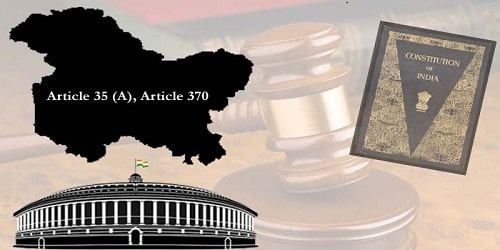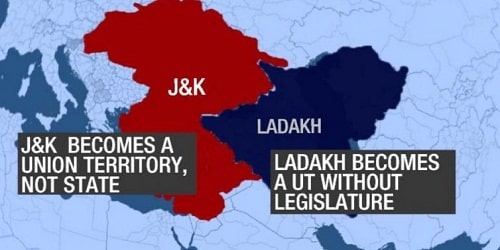On August 5, 2019, Government announced to repeal Article 370 [except the first clause 370 (1)] and Article 35A which grants special status to Jammu and Kashmir (J&K). Union Home Minister Amit Shah announced to bifurcate the state into 2 Union Territories – Jammu and Kashmir, which will have a legislature like Delhi and Puducherry, and Ladakh, which will be without a legislature like Chandigarh. About Article 370:
About Article 370:
- History: In October 1947, the then-Maharaja Hari Singh of Kashmir signed the ‘Instrument of Accession’, which specified three subjects- Foreign affairs, Defence and Communications on which J&K would transfer its powers to the government of India. In July 1949, Sheikh Abdullah, the then chief minister of J&K, and three other colleagues joined the Indian Constituent Assembly and negotiated the special status of J&K, leading to the adoption of Article 370.
- Provision of Article 370: Parliament needs the J&K government’s nod for applying laws in the state except for defence, foreign affairs, finance, and communications. Citizens from other states cannot buy property in J&K and the Centre has no power to declare financial emergency. It binds the state of J&K to the Indian Union.
- Article 370(1)(c): It explicitly mentions that Article 1 of the Indian Constitution applies to Kashmir through Article 370. Article 1 lists the states of the Union.
- Laws not applicable due to Article 370: Due to Article 370, Right of Children to Free and Compulsory Education (RTE), Right to Information (RTI), CAG and many Indian laws aren’t applicable in Kashmir which has a situation of corruption.
About Article 35A:
- It gives the J&K Legislature full discretionary power to decide who the ‘permanent residents’ of the state are. It gives them special rights and privileges regarding employment with the state government, acquisition of property in the state, settling in the state, and the right to scholarships and other forms of aid that the state government provides. It allows the state legislature to impose any restrictions upon persons other than the permanent residents regarding the above.
- Consequence if repealed: Before Article 35A was introduced to the Constitution of India, the Governor and the Chief Minister of J&K were addressed as the Sadr-e-Riyasat (President) and Wazir-e-Azam (Prime Minister). If Article 35A is repealed, it would lead J&K back to the same arrangement.
Jammu and Kashmir Reorganisation Bill, 2019 passed in Rajya Sabha
Union Home Minister Amit Shah introduced the Jammu and Kashmir Reorganization Bill, 2019 in Rajya Sabha which seeks to bifurcate the state of Jammu and Kashmir into 2 Union territories – J&K a Union Territory with Legislature, and Ladakh Union Territory without Legislature. He claimed that due to Article 370, development of the state could not be possible. It was passed in Rajya Sabha with 125 votes in favour and 61 votes against it.
- The Union Territory of Ladakh will include the districts Leh & Kargil which will, in effect, cease to be part of the existing state of Jammu and Kashmir. It will be administered by the Lieutenant Governor alone. The remaining territories will remain with Jammu and Kashmir after the bifurcation.
- Reason: The J&K region was declared to be a Union Territory on account of prevalent cross border terrorism which had compromised internal security of the state.
- Representation in the House of People: Out of the six Lok Sabha seats in the state of Jammu and Kashmir, 5 will remain with the Union Territory of J&K and one will go to the Union Territory of Ladakh. The Election Commission may conduct Lok Sabha elections for both the Union Territories as per the allocation of seats specified in the Delimitation of Parliamentary Constituencies Order, 1976 as amended by this act.
- Tenure: The J&K Legislative Assembly will have a tenure of 5 years unless it is dissolved earlier by the Lieutenant Governor (L-G). Provisions contained under Article 239a of the constitution are applicable. The bill states that the number of seats in the Legislative Assembly of J&K shall be increased from 107 to 114.
- High Court: The High Court of the existing state of Jammu and Kashmir will be the common High Court of the two Union Territories.
- Lieutenant Governor: The President shall appoint the L-G under article 239. Union Territory of J&K and the Union Territory of Ladakh will have a common L-G. The Chief Minister shall be appointed by the L-G who will also appoint other ministers with the aid of the CM.
- Largest UT: J&K will be the largest UT in India in terms of area and Ladakh will become the second largest UT. With the inclusion of 2 new UTs, the total number of UTs in India will stand at 9- J&K, Ladakh, Delhi, Puducherry, Diu & Daman, Dadra & Nagar Haveli, Chandigarh, Lakshadweep and Andaman & Nicobar Islands.
Jammu and Kashmir Reservation (Second Amendment) Bill, 2019 passed in Rajya Sabha
Jammu and Kashmir Reservation (Second Amendment) Bill, 2019, was also passed in Rajya Sabha which seeks to implement the 10% Economically Weaker Section (EWS) quota in Jammu and Kashmir.
President issues Constitution (Application to Jammu and Kashmir) Order 2019 superseding 1954 order
On August 5, 2019, President Ram Nath Kovind in “concurrence” with the “Jammu and Kashmir government” promulgated Constitution (Application to Jammu and Kashmir) Order, 2019 which states that provisions of the Indian Constitution are applicable in the state. It comes into force “at once”, and shall supersede the Constitution (Application to Jammu and Kashmir) Order, 1954. The government added in Article 367 of the Constitution a clause 4 which made 4 changes. The following are the changes:
- The order said references to the person for the time being recognized by the president on the recommendation of the Legislative Assembly of the State as the Sadar-i-Riyasat of Jammu and Kashmir, acting on the advice of the Council of Ministers of the state for the time being in office, shall be construed as references to the Governor of Jammu and Kashmir.
- References to the Governor of Jammu and Kashmir shall be construed as including references to the Governor of Jammu and Kashmir acting on the advice of his Council of Ministers.
- In proviso to clause (3) of Article 370 of this Constitution, the expression “Constituent Assembly of the State referred to in clause (2)” shall read “Legislative Assembly of the State”
About Constitution (Application to Jammu and Kashmir) Order, 1954:
It came into force on 14 May 1954. It was a comprehensive order seeking to implement the 1952 Delhi Agreement. The provisions of Delhi Agreement were: Indian citizenship was extended to the ‘permanent residents’ of Jammu and Kashmir, infusion of Article 35A, extension of the fundamental rights of the Indian constitution to J&K, extension of the jurisdiction of the Supreme Court and Central Government was given power to declare a national emergency in the event of external aggression




